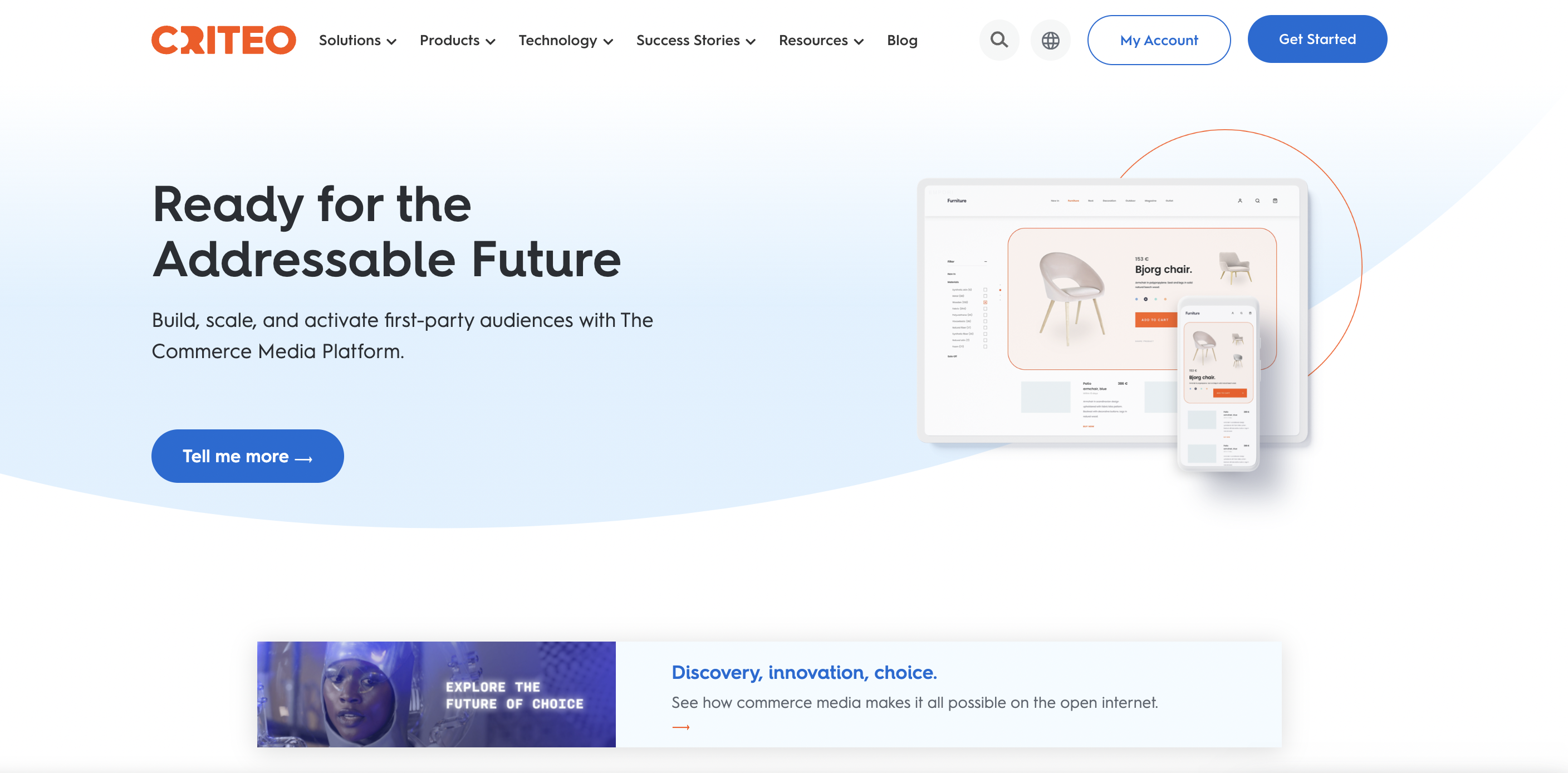“Zwei Jahre Pandemie in der Analyse: Welche Trends werden Marketing und Commerce nachhaltig verändern?” Interview with Corinna Hohenleitner Managing Director DACH @ Criteo Ulrich Kaleta e-Commerce Consultant und Interim Manager
Written by
Editorial TeamPublished on

We’re more than happy to introduce some speakers of our upcoming E-commerce Berlin Expo 2022.
Today, we decided to invite Ulrich Kaleta e-Commerce Consultant und Interim Manager and Corinna Hohenleitner Managing Director DACH @ Criteo “Zwei Jahre Pandemie in der Analyse: Welche Trends werden Marketing und Commerce nachhaltig verändern?” Enjoy!
The year 2020 has revolutionized ecommerce, it goes without saying. According to you, what was
the most significant change that the pandemic caused in the industry?
Corinna: Consumer needs and expectations have undergone a fundamental change. Compared to
just a couple of years ago, consumers use more digital services, more frequently and in many
different ways. The smartphone is now the linchpin of shopping even in brick-and-mortar retail, and
although its role is not losing importance, it is demonstrably changing. For example, Criteo research
has shown that 47 percent of consumers in Germany now use their smartphone in a physical store
to complete an order online.
With competition just one click away in-store, the physical shopping environment has become
infinitely more competitive. According to our insights, 55 percent of consumers recall browsing
products on their phone while in a store, only to make the purchase on another retailer’s website or
app. Retailers must successfully address the needs of these omnichannel shoppers to retain them.
Uli: In a lot of cases consumers adopted online-first shopping behaviours out of sheer necessity. But
over the last two years, most retailers have done a fantastic job of shifting focus to the online
experience they provide, ensuring everything from product search to delivery logistics enable
smooth transactions. Today, with greater choice between online and offline, the continued
popularity of online sales channels across all age groups reflects their success.
Rather than a competitive differentiator, the online experience is a fundamental part of retail today
and any shops still without a digital shopfront will be missing out. This isn’t to say it’s time for high
street retailers to cut back on their physical footprint. The lifetime value of omnichannel consumers
is still greater than online-only shoppers. Equally many sectors – right the way through to medical
solutions – still need the face-to-face interaction.
All of these changes were temporary, would they have happened anyway, or were they
accelerated because of the pandemics?
Corinna: The conditions caused by the pandemic clearly accelerated the adoption of digital services.
Let’s take omnichannel as an example: many retailers were already working on omnichannel
concepts in 2019 and before, but either haven’t implemented them or just on a limited scope. In
2020, social distancing and lockdowns were drivers of mass adoption of services like Click & Collect.
Retailers suddenly needed to prioritise the roll-out of such services, and they will benefit from them
in the long-term. Consumers have learned about the benefits of those services, they are more likely
now to pay a fee and pick up their order instead of spending hours in-store finding their products
and queuing at the checkouts. The pandemic has been catalyst of trends we’ve been experiencing
for some time.
Uli: The pandemic certainly worked as an accelerator. Retail banks in several markets reported five
years’ worth of online sales growth in the first 12 months alone. The sheer volume of demand,
mixed with the fact many established retailers were playing catch-up to get their online store in
order, resulted in a general acceptance that online shopping would be ‘rough around the edges’. As life comes back to normal, any remaining structural failures will reflect far more on the retailer and
likely carry the cost of losing customer loyalty.

Ulrich, you implemented strategies for various brands for over 60 markets. What is your very first
step when you start working for them, and how do you prioritize your actions?
Uli: The first step is always to understand what audiences a brand has and what those audiences are
looking for from the business. Focusing on the right data here is essential. Once you have a clear
picture of demand, you’re able to draw sound conclusions about any shortcomings within the
business and at this point begin to consider how they might be addressed. A plan of action without
insight is a ship without a map, it’ll never make it to its destination.
What do you think is the most important element of an effective eCommerce marketing
campaign?
Corinna: Clearly, first-party data is the future of digital advertising and commerce. It is the key to
mastering the balancing act between data protection and the individual user experience. Companies
have a lot of first-party data, be it identity data, measurement data or commerce data. Each of these
are important elements of a holistic customer view. For retailers, connecting first-party data and
activating a first-party data led strategy is vital in meeting customers’ needs across channels,
including offline.
How can businesses make sure their performance marketing campaigns are successful?
Uli: Again, it comes down to data. Data is the fuel of performance marketing. For a long time
businesses have looked beyond their borders to understand customers and how to attract a greater
market share. With recent regulatory changes, there’s a reassuring focus back on the business’s own
first-party data, and understanding what that is telling them. Where brands and media owners are
able to come together and reconcile what this first-party data is telling them and use it to identify
relevant audiences, performance marketing capabilities are revolutionised.

What are you going to cover during the E-commerce Berlin Expo?
Corinna: We’ve talked a little already about how quickly commerce has changed since March 2020,
but it’s worth reflecting on the breadth of the disruption. From the surging demand of consumers
working from home, to months of delivery delays, fierce new online competition as traditional chain
stores launched online and even unprecedented discounts from warehouses overspilling with
products that hadn’t been sold. Most retailers will know what I mean and are wondering how to deal
with these matters in the mid- to long-term. And that’s precisely the goal of our session at E-
commerce Berlin Expo. We’ll look into Criteo’s broad data base of 22,000 global retailers, we’ll
enrich the insights with results from various actual consumer surveys, and most importantly, we’ll
do a sanity-check of data and retailers’ experiences in order to identify sustainable key trends. We
are planning to provide a data-based analysis for all retailers who want to future-proof their
business now.
You are both experts in the field. What would be your top advice for retailers who want to future-
proof their business? Is there anything that could apply to each and every retailer?
Corinna: The time of first-party data has come. While tech giants like Apple and Google are
reviewing and changing how advertisers can operate within their platforms, the future of first-party data is assured. Retailers are sitting on a treasure trove of online and offline data (just think about
loyalty cards alone), but they are still far from realising its full potential. The task is to make this data
usable beyond its core function and to activate it across the board for addressing target audiences.
To do this, retailers must deal with the technological and legal foundations and establish data
governance frameworks in the company that create a solid basis for an effective data strategy.
Uli: Three core ingredients that are almost ubiquitous across successful retailers are their user
centricity, a solid data structure and a clear strategy. All too often businesses feel they’re missing
some insight that must exist beyond the data they have. What is needed is the addition of
intelligence to the data that they already hold. By tying the strategy to what first-party data is telling
the business about its customers, far more value is extracted, contextual responses are made faster
and outcomes are maximised.




